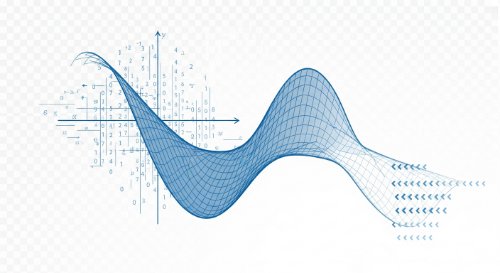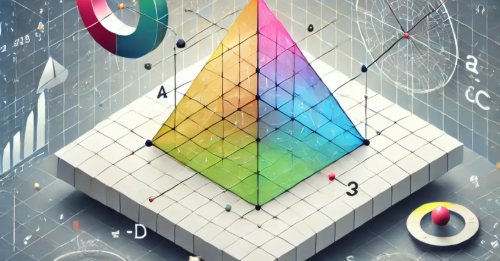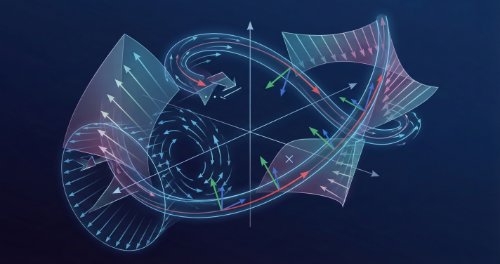Vector Algebra and Geometry - Vectors (Undergraduate Foundation)
415
21 hrs
 GET 209: Engineering Mathematics IMaster the mathematical language of engineering. This programme delivers the complete analytical toolkit required for a successful engineering career, covering single-variable calculus, multivariable calculus, linear algebra, and vector analysis. It provides the essential foundation for all subsequent engineering courses.
This programme is for second-year undergraduate students across all engineering disciplines. It delivers the official NUC CCMAS curriculum for Engineering Mathematics, providing the core training required for advanced modules in mechanics, thermodynamics, and circuit theory.
Model and analyse complex physical systems using calculus, linear algebra, and vector analysis. You will be equipped to solve problems in dynamics, statics, and field theory, providing the quantitative proficiency required for advanced engineering study and professional practice.
GET 209: Engineering Mathematics IMaster the mathematical language of engineering. This programme delivers the complete analytical toolkit required for a successful engineering career, covering single-variable calculus, multivariable calculus, linear algebra, and vector analysis. It provides the essential foundation for all subsequent engineering courses.
This programme is for second-year undergraduate students across all engineering disciplines. It delivers the official NUC CCMAS curriculum for Engineering Mathematics, providing the core training required for advanced modules in mechanics, thermodynamics, and circuit theory.
Model and analyse complex physical systems using calculus, linear algebra, and vector analysis. You will be equipped to solve problems in dynamics, statics, and field theory, providing the quantitative proficiency required for advanced engineering study and professional practice.
Master the mathematical language of engineering. This programme delivers the complete analytical toolkit required for a successful engineering career, covering single-variable calculus, multivariable calculus, linear algebra, and vector analysis. It provides the essential foundation for all subsequent engineering courses. This programme is for second-year undergraduate students across all engineering disciplines. It delivers the official NUC CCMAS curriculum for Engineering Mathematics, providing the core training required for advanced modules in mechanics, thermodynamics, and circuit theory. Model and analyse complex physical systems using calculus, linear algebra, and vector analysis. You will be equipped to solve problems in dynamics, statics, and field theory, providing the quantitative proficiency required for advanced engineering study and professional practice.
 MTH 103: Elementary Mathematics III - Vectors, Geometry and DynamicsThis comprehensive learning track guides you through the complete world of vector analysis. We begin with the fundamentals of vector algebra and its application to foundational geometry. You will then master scalar, vector, and triple products before using them to construct the vector equations of lines, planes, and conics. The journey culminates in advanced topics, including vector calculus, its applications in classical mechanics, and an introduction to differential geometry.
Vectors are the essential language used to describe our physical world, making their mastery non-negotiable for any serious student of science or engineering. This track is designed to build your intuition for spatial reasoning and equip you with a powerful problem-solving toolkit. You will see direct applications in mechanics, analyzing forces and motion; in geometry, calculating angles and distances; and in calculus, modeling dynamic change over time.
While this track is tailored to the first-year university curriculum for MTH 104 at Obafemi Awolowo University, Ile-Ife, Nigeria, it is an invaluable resource for a wide range of learners. It is ideal for any undergraduate student in mathematics, physics, engineering, or computer science seeking a comprehensive understanding of vector analysis. Furthermore, it serves as an excellent and thorough refresher for professionals who wish to solidify their foundational knowledge of this critical subject.
MTH 103: Elementary Mathematics III - Vectors, Geometry and DynamicsThis comprehensive learning track guides you through the complete world of vector analysis. We begin with the fundamentals of vector algebra and its application to foundational geometry. You will then master scalar, vector, and triple products before using them to construct the vector equations of lines, planes, and conics. The journey culminates in advanced topics, including vector calculus, its applications in classical mechanics, and an introduction to differential geometry.
Vectors are the essential language used to describe our physical world, making their mastery non-negotiable for any serious student of science or engineering. This track is designed to build your intuition for spatial reasoning and equip you with a powerful problem-solving toolkit. You will see direct applications in mechanics, analyzing forces and motion; in geometry, calculating angles and distances; and in calculus, modeling dynamic change over time.
While this track is tailored to the first-year university curriculum for MTH 104 at Obafemi Awolowo University, Ile-Ife, Nigeria, it is an invaluable resource for a wide range of learners. It is ideal for any undergraduate student in mathematics, physics, engineering, or computer science seeking a comprehensive understanding of vector analysis. Furthermore, it serves as an excellent and thorough refresher for professionals who wish to solidify their foundational knowledge of this critical subject.
This comprehensive learning track guides you through the complete world of vector analysis. We begin with the fundamentals of vector algebra and its application to foundational geometry. You will then master scalar, vector, and triple products before using them to construct the vector equations of lines, planes, and conics. The journey culminates in advanced topics, including vector calculus, its applications in classical mechanics, and an introduction to differential geometry. Vectors are the essential language used to describe our physical world, making their mastery non-negotiable for any serious student of science or engineering. This track is designed to build your intuition for spatial reasoning and equip you with a powerful problem-solving toolkit. You will see direct applications in mechanics, analyzing forces and motion; in geometry, calculating angles and distances; and in calculus, modeling dynamic change over time. While this track is tailored to the first-year university curriculum for MTH 104 at Obafemi Awolowo University, Ile-Ife, Nigeria, it is an invaluable resource for a wide range of learners. It is ideal for any undergraduate student in mathematics, physics, engineering, or computer science seeking a comprehensive understanding of vector analysis. Furthermore, it serves as an excellent and thorough refresher for professionals who wish to solidify their foundational knowledge of this critical subject.
 MTH 210: Vector AnalysisVector analysis is the mathematical backbone of classical mechanics, electromagnetism, and fluid dynamics. This learning track delivers the complete NUC CCMAS MTH 210 curriculum, rigorously progressing from fundamental vector algebra to the advanced differential and integral calculus of scalar and vector fields used in complex engineering and scientific modelling.
This programme is targeted at undergraduates in engineering, physics, mathematics, and computer science. It provides the essential mathematical toolkit for students entering disciplines that rely on applied mathematics and spatial analysis, and serves as a rigorous refresher for professionals needing to solidify their command of vector principles.
You will master the full spectrum of vector operations including dot, cross, and triple products, and apply them to solve geometric problems and vector equations. You will acquire the skills to analyze the differential geometry of curves using the Frenet-Serret framework and apply the powerful gradient, divergence, curl, and Laplacian operators in various coordinate systems. Completion establishes the critical mathematical foundation demanded for advanced studies in continuum mechanics, electrodynamics, and theoretical physics.
MTH 210: Vector AnalysisVector analysis is the mathematical backbone of classical mechanics, electromagnetism, and fluid dynamics. This learning track delivers the complete NUC CCMAS MTH 210 curriculum, rigorously progressing from fundamental vector algebra to the advanced differential and integral calculus of scalar and vector fields used in complex engineering and scientific modelling.
This programme is targeted at undergraduates in engineering, physics, mathematics, and computer science. It provides the essential mathematical toolkit for students entering disciplines that rely on applied mathematics and spatial analysis, and serves as a rigorous refresher for professionals needing to solidify their command of vector principles.
You will master the full spectrum of vector operations including dot, cross, and triple products, and apply them to solve geometric problems and vector equations. You will acquire the skills to analyze the differential geometry of curves using the Frenet-Serret framework and apply the powerful gradient, divergence, curl, and Laplacian operators in various coordinate systems. Completion establishes the critical mathematical foundation demanded for advanced studies in continuum mechanics, electrodynamics, and theoretical physics.
Vector analysis is the mathematical backbone of classical mechanics, electromagnetism, and fluid dynamics. This learning track delivers the complete NUC CCMAS MTH 210 curriculum, rigorously progressing from fundamental vector algebra to the advanced differential and integral calculus of scalar and vector fields used in complex engineering and scientific modelling. This programme is targeted at undergraduates in engineering, physics, mathematics, and computer science. It provides the essential mathematical toolkit for students entering disciplines that rely on applied mathematics and spatial analysis, and serves as a rigorous refresher for professionals needing to solidify their command of vector principles. You will master the full spectrum of vector operations including dot, cross, and triple products, and apply them to solve geometric problems and vector equations. You will acquire the skills to analyze the differential geometry of curves using the Frenet-Serret framework and apply the powerful gradient, divergence, curl, and Laplacian operators in various coordinate systems. Completion establishes the critical mathematical foundation demanded for advanced studies in continuum mechanics, electrodynamics, and theoretical physics.
Course Chapters
1. Introduction5
Definitions of scalars, vectors and tensors; representation of a vector by a directed line segment; kinds of vectors - free, localized, equal, null, unit, like and unlike vectors.
Chapter lessons
1-2. Definition57:41
2. Vector Algebra65
Vector addition - triangle and parallelogram laws; multiplication of a vector by a scalar; relations on mid-points of sides of a triangle; vector algebra on quadrilaterals and other polygons; parallel vectors; laws of vector algebra.
Chapter lessons
2-6. Parallel vectors27:49
3. Position Vectors12
4. Vector Components45
Meaning of vector components; resolution of vectors into components in two and three dimensions; unit vectors, direction cosines and angle between two vectors in the three-dimensional Cartesian coordinate system.
Chapter lessons
4-1. Definition17:56
4-3. Cartesian components (2)43:36
4-4. Direction cosines22:13
5. Division of a Line33
Ratio Division of a line internally and externally; collinearity of points.
Chapter lessons
6. Vector Projections22
7. Centroids22
Mean centre (geometric centre) of a number of points; weighted mean centres.
Chapter lessons
7-1. Centroid8:07
Meaning and analysis of the centroid of a number of points.
7-2. Weighted mean12:21
Meaning and analysis of the weighted mean of a number of points.